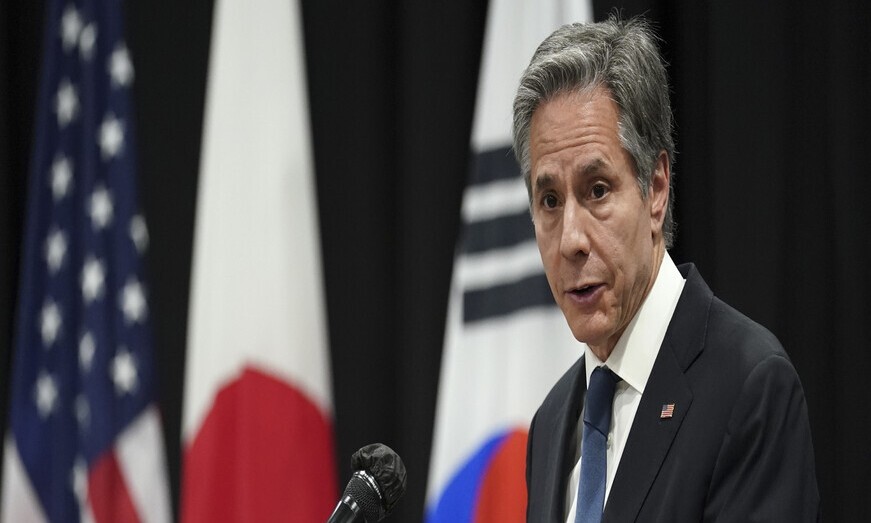hankyoreh
Links to other country sites 다른 나라 사이트 링크
Biden’s Indo-Pacific strategy aims to rein in China via alliances with S. Korea, Japan

The administration of US President Joe Biden has put forward a strategy for the Indo-Pacific with the chief aim of containing China’s rise.
In particular, the Biden administration’s foreign policy has stressed the importance of alliances, with a noticeable emphasis on the role of allies in the Quad framework and trilateral cooperation with South Korea and Japan.
A 12-page document titled “Indo-Pacific Strategy of the United States” released by the White House on Friday referred to the US as “an Indo-Pacific power,” stressing that the US would “focus on every corner of the region, from Northeast Asia and Southeast Asia, to South Asia and Oceania, including the Pacific Islands.”
The document shared the Biden administration’s strategic perceptions and plan of action in connection with the “Indo-Pacific,” a concept which was established during the administration of predecessor Donald Trump with an eye toward reining in Beijing. The US Defense Department published an “Indo-Pacific Strategy Report” in June 2019, while Trump was in office.
Citing “mounting challenges, particularly from the [People’s Republic of China]” as a reason for focusing more on a region that is of growing strategic and economic importance to the US, the Biden administration referred to China as “combining its economic, diplomatic, military, and technological might as it pursues a sphere of influence in the Indo-Pacific and seeks to become the world’s most influential power.”
The strategy further said the US plans to “manage competition with the PRC responsibly.”
“Our collective efforts over the next decade will determine whether the PRC succeeds in transforming the rules and norms that have benefitted the Indo-Pacific and the world,” it predicted.
Stressing that efforts to achieve the goal of a “free and open Indo-Pacific” have to start with the US’ allies and partners, the strategy said the US was “deepening [its] five regional treaty alliances” with Australia, Japan, South Korea, the Philippines, and Thailand. It also mentioned the strengthening and modernization of its relationships with allies as “strategic means” and “strategic ways” of achieving goals.
Its reference to the five allies and partners as “our single greatest asymmetric strength” also signaled Washington’s intent to make active use of them in keeping China contained. As additional means of cooperation, the strategy referred to the Quad — a strategic security dialogue among the US, Japan, India, and Australia in response to China — and an “Indo-Pacific economic framework” that it plans to put forward early this year to target China in the economic realm.
This contrasts the strategy adopted by the Trump administration, which disregarded allies on important matters.
The strategy singled out relations between Seoul and Tokyo in its reference to plans for encouraging stronger relationships among partners and allies. While it included various “action plans” for achieving its strategic goals, it also stressed, “Nearly every major Indo-Pacific challenge requires close cooperation among the United States’ allies and partners, particularly Japan and the ROK.”
This reflects Washington’s perception that the strain in relations between Seoul and Tokyo is becoming a stumbling block in responding to China and North Korea.
While the strategy mentioned the administration’s willingness to pursue dialogue with North Korea, it also announced the US’ intent to strengthen its extended deterrence in response to the North’s nuclear armament.
In the strategy, the administration said it would “continue to seek serious and sustained dialogue, with the goal of complete denuclearization of the Korean Peninsula and addressing its ongoing human-rights violations and improving the lives and livelihoods of the North Korean people.”
At the same time, it noted that the US was “strengthening extended deterrence and coordination with the ROK and Japan to respond to DPRK provocations, remaining prepared to deter — and, if necessary, defeat — any aggression to the United States and our allies, while bolstering counter-proliferation efforts throughout the region.”
By Lee Bon-young, Washington correspondent
Please direct questions or comments to [english@hani.co.kr]

Editorial・opinion
![[Editorial] Penalties for airing allegations against Korea’s first lady endanger free press [Editorial] Penalties for airing allegations against Korea’s first lady endanger free press](https://flexible.img.hani.co.kr/flexible/normal/500/300/imgdb/original/2024/0502/1817146398095106.jpg) [Editorial] Penalties for airing allegations against Korea’s first lady endanger free press
[Editorial] Penalties for airing allegations against Korea’s first lady endanger free press![[Editorial] Yoon must halt procurement of SM-3 interceptor missiles [Editorial] Yoon must halt procurement of SM-3 interceptor missiles](https://flexible.img.hani.co.kr/flexible/normal/500/300/imgdb/child/2024/0501/17145495551605_1717145495195344.jpg) [Editorial] Yoon must halt procurement of SM-3 interceptor missiles
[Editorial] Yoon must halt procurement of SM-3 interceptor missiles- [Guest essay] Maybe Korea’s rapid population decline is an opportunity, not a crisis
- [Column] Can Yoon steer diplomacy with Russia, China back on track?
- [Column] Season 2 of special prosecutor probe may be coming to Korea soon
- [Column] Park Geun-hye déjà vu in Yoon Suk-yeol
- [Editorial] New weight of N. Korea’s nuclear threats makes dialogue all the more urgent
- [Guest essay] The real reason Korea’s new right wants to dub Rhee a founding father
- [Column] ‘Choson’: Is it time we start referring to N. Korea in its own terms?
- [Editorial] Japan’s rewriting of history with Korea has gone too far
Most viewed articles
- 160% of young Koreans see no need to have kids after marriage
- 2Presidential office warns of veto in response to opposition passing special counsel probe act
- 3Months and months of overdue wages are pushing migrant workers in Korea into debt
- 4Hybe-Ador dispute shines light on pervasive issues behind K-pop’s tidy facade
- 5Japan says it’s not pressuring Naver to sell Line, but Korean insiders say otherwise
- 6[Reporter’s notebook] In Min’s world, she’s the artist — and NewJeans is her art
- 7[Editorial] Penalties for airing allegations against Korea’s first lady endanger free press
- 8Inside the law for a special counsel probe over a Korean Marine’s death
- 9OECD upgrades Korea’s growth forecast from 2.2% to 2.6%
- 10[Exclusive] Hanshin University deported 22 Uzbeks in manner that felt like abduction, students say